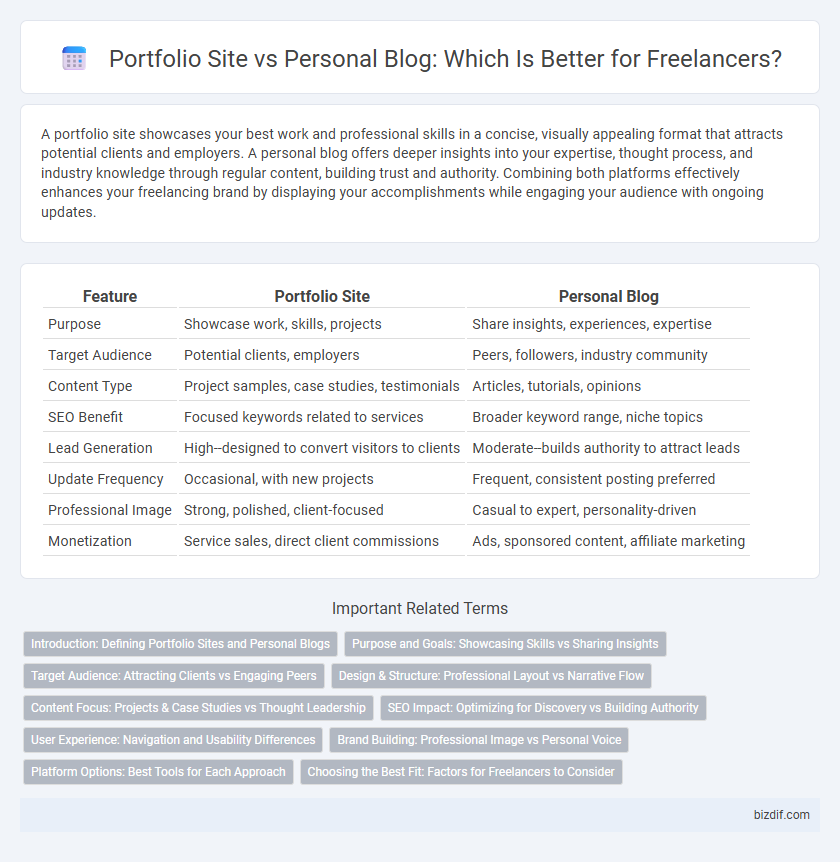A portfolio site showcases your best work and professional skills in a concise, visually appealing format that attracts potential clients and employers. A personal blog offers deeper insights into your expertise, thought process, and industry knowledge through regular content, building trust and authority. Combining both platforms effectively enhances your freelancing brand by displaying your accomplishments while engaging your audience with ongoing updates.
Table of Comparison
| Feature | Portfolio Site | Personal Blog |
|---|---|---|
| Purpose | Showcase work, skills, projects | Share insights, experiences, expertise |
| Target Audience | Potential clients, employers | Peers, followers, industry community |
| Content Type | Project samples, case studies, testimonials | Articles, tutorials, opinions |
| SEO Benefit | Focused keywords related to services | Broader keyword range, niche topics |
| Lead Generation | High--designed to convert visitors to clients | Moderate--builds authority to attract leads |
| Update Frequency | Occasional, with new projects | Frequent, consistent posting preferred |
| Professional Image | Strong, polished, client-focused | Casual to expert, personality-driven |
| Monetization | Service sales, direct client commissions | Ads, sponsored content, affiliate marketing |
Introduction: Defining Portfolio Sites and Personal Blogs
Portfolio sites showcase a freelancer's professional work, skills, and achievements in a visually organized layout to attract potential clients or employers. Personal blogs focus on sharing insights, experiences, and expertise through regular posts, fostering engagement and personal branding. Both serve unique roles in building an online presence but emphasize different aspects of a freelancer's professional identity.
Purpose and Goals: Showcasing Skills vs Sharing Insights
A portfolio site is designed to showcase skills, projects, and professional achievements, serving as a visual resume for potential clients and employers in freelancing. A personal blog emphasizes sharing insights, experiences, and expertise, helping freelancers build thought leadership and engage with a broader audience. Both platforms support career growth but differ in purpose: one highlights tangible work, while the other fosters community and knowledge exchange.
Target Audience: Attracting Clients vs Engaging Peers
A portfolio site is designed to showcase skills and completed projects, targeting potential clients seeking professional services, which helps in building trust and securing contracts. A personal blog, on the other hand, caters to engaging peers by sharing industry insights, experiences, and thought leadership, fostering community and professional networking. Understanding these audience distinctions enables freelancers to tailor content strategically for client acquisition or peer engagement.
Design & Structure: Professional Layout vs Narrative Flow
A portfolio site features a professional layout designed to showcase skills, projects, and achievements with clear sections, concise descriptions, and visually appealing elements to attract potential clients. In contrast, a personal blog emphasizes a narrative flow with chronological posts that build personal stories and insights, fostering reader engagement through authentic voice and continuous content updates. Optimizing design and structure depends on the freelancing goal: portfolio sites drive client acquisition, while personal blogs enhance relationship-building through storytelling.
Content Focus: Projects & Case Studies vs Thought Leadership
A portfolio site emphasizes showcasing projects and detailed case studies to demonstrate skills and results to potential clients, highlighting practical experience and tangible achievements. In contrast, a personal blog centers on thought leadership by sharing industry insights, opinions, and expertise, which helps build credibility and engage a professional audience over time. Combining both approaches can create a comprehensive online presence that attracts clients through proven work and insightful content.
SEO Impact: Optimizing for Discovery vs Building Authority
A portfolio site enhances SEO impact by targeting keywords related to specific skills and completed projects, boosting discovery through precise search intent matching. Personal blogs build authority by regularly publishing in-depth, keyword-rich content that addresses industry trends, insights, and challenges, increasing organic reach and trustworthiness. Balancing a portfolio's project-focused SEO with a blog's content-driven authority cultivation maximizes freelance visibility and client engagement.
User Experience: Navigation and Usability Differences
Portfolio sites prioritize streamlined navigation with clear categories showcasing skills and completed projects, enhancing usability for potential clients seeking quick, relevant information. Personal blogs often feature chronological content that encourages exploration and reader engagement but may require more effort to locate specific expertise or services. Optimizing for user experience in freelancing means tailoring site structure to ensure intuitive access to professional credentials and work samples.
Brand Building: Professional Image vs Personal Voice
A portfolio site emphasizes brand building by showcasing a professional image with curated work samples, client testimonials, and clear service offerings that attract potential clients. A personal blog highlights personal voice and expertise through regular, authentic content that fosters trust and engagement with an audience. Both platforms contribute to freelancing success by balancing polished presentation and genuine connection.
Platform Options: Best Tools for Each Approach
Portfolio sites excel on platforms like Squarespace and Wix, offering visually stunning templates tailored for showcasing work samples and client testimonials. Personal blogs thrive on WordPress and Medium, providing customizable layouts and robust content management suited for storytelling, thought leadership, and regular updates. Choosing the right platform depends on your goal: polished, professional presentation or engaging, dynamic content creation.
Choosing the Best Fit: Factors for Freelancers to Consider
Freelancers should evaluate the primary purpose of their online presence when deciding between a portfolio site and a personal blog. A portfolio site effectively showcases skills, completed projects, and client testimonials, directly appealing to potential clients seeking specific expertise. In contrast, a personal blog emphasizes thought leadership and ongoing industry insights, which can build authority and foster long-term engagement with a broader audience.
Portfolio site vs Personal blog Infographic

 bizdif.com
bizdif.com